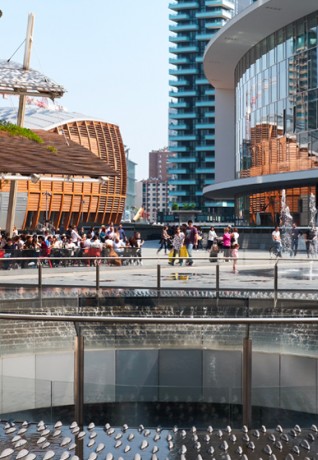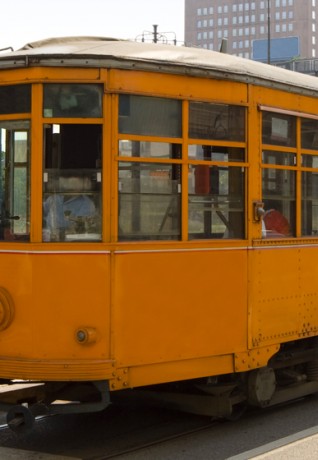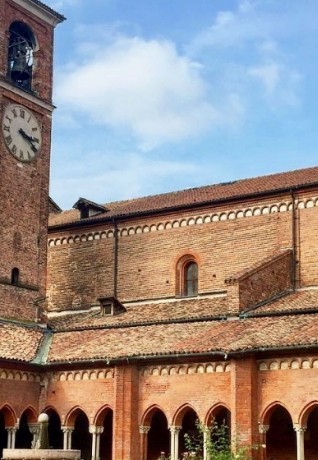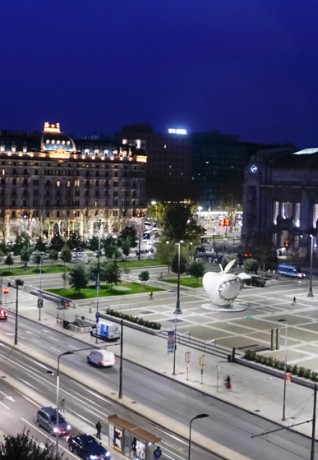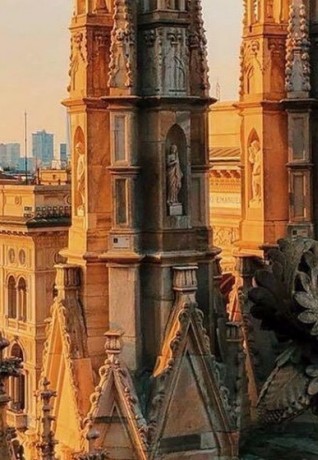Accessible itinerary: Leonardo's Milano
From Cadorna to Sant'Ambrogio

The starting point of this itinerary is piazzale Cadorna.
How to get there
Piazzale Cadorna can be reached by many public transport: underground M1 and M2 (Cadorna stop); tram 1; buses: 50, 58, 61, 94.
For more information for passengers with disabilities, please visit the ATM web page.
Nearby, it is possible to park in via Pietro Paleocapa (blue stripes).
On the right side of the station, at the taxi rank, there are three parking spaces reserved for disabled pass holders.
The starting point of this itinerary is Piazzale Cadorna, one of the most important squares in Milano, overlooked by the historic building of the Ferrovie Nord Milano railway station. In the year 2000, the square underwent a significant urban restyling based on a project by architect Gae Aulenti, who furnished it with shelters and with the installation of the sculpture "Needle and thread" which symbolizes Milano's industriousness.
Following a path of about 500 m, from Piazza Cadorna walk along Via Carducci then turn right into Corso Magenta where, at number 61, you can admire the Palazzo dei Congressi, known as the "Stelline". The building stands where the Stelline girls' orphanage, commissioned by Federico Borromeo, once was.
Of the original building today we can only admire the facade walls, some vaulted rooms and the portico of the main courtyard.
Along Corso Magenta opens the square (pedestrian area with the presence of seats and paved flooring) where you can find the Basilica of Santa Maria delle Grazie, a Milanese Renaissance masterpiece, built in the place where once stood a chapel with a fresco depicting a Madonna delle Grazie.
The basilica, commissioned by Ludovico il Moro, was built for the Dominican friars between 1466 and 1490. The interior, with three naves, is full of important works of art.
The Sagrestia Vecchia (Old Sacristy) and the cloister are attributed to Bramante; in the former refectory of the Dominican convent, located to the left of the facade of the church, you can admire one of the most famous paintings in the world: Leonardo da Vinci's Last Supper.
The Last Supper is one of the masterpieces of all time, that still attracts and is admired by tourists and art lovers from all over the world.
The work is particularly fragile and delicate and the entrance is strictly disciplined: 35 people can access it at a time and the visit takes 15 minutes. This is the reason why we advise you to book your visit well in advance.
If you want to get to know Leonardo's genius better, you cannot miss a visit to the Museo Scienza e Tecnologia Leonardo da Vinci (Leonardo da Vinci Museum of Science and Technology), located near the place where Leonardo owned some vineyards.
The museum, housed in the ancient rooms of the monastery of San Vittore, holds the largest collection in the world of machine models made from the designs of the Genius from Tuscany.
To reach the Museum from Piazza Santa Maria delle Grazie, go back in the direction of the Casa degli Ateliani museum and Leonardo's vineyard, cross Corso Magenta (paved crossing, sometimes uneven, with tram rails), take via Bernardino Zenale on the right sidewalk (at first it is only 90 cm wide and delimited by iron stakes, then after 50 meters it becomes very wide), go along it for about 200 meters and turn left in via San Vittore. The sidewalk, on the left side of the street, is quite wide.
Continue for about 150 meters and when you reach number 14 of via San Vittore, cross the road using the pedestrian crossing (crossing in uneven paving, with tram rails) and go immediately to the right on the opposite sidewalk and then turn the corner on the left and you will find yourself in the square where the museum entrance is located.
In the square you can also visit the Chiesa di San Vittore, the former basilica of the Olivetan Friars, who lived in the adjoining monastery (the church is accessible thanks to an inclined paved ramp on the left side of the façade; the pavement of the square is in uneven cobblestones and there is a central path in good conditions).
The small concrete and marble ramp that leads from the square to the sidewalk is not in good condition, but still usable.
Walk down via San Vittore on the right side for about 300 meters (asphalt pavement with ventilation grates), cross via Carducci (traffic light with acoustic signal), go through the Pusterla di Sant'Ambrogio (one of the minor medieval gates in Milan) and after a short walk (uneven cobblestones) you reach Piazza Sant'Ambrogio, where the basilica dedicated to the patron saint of Milano is.
The Basilica di Sant’Ambrogio is located in a pedestrian area (stone-paved); the church was built between 379 and 386 commissioned by Bishop Ambrogio, in the area of the cemetery where the Christians martyred by Roman persecutions were buried.
The basilica has three naves, three apses and an atrium and represents an isolated example of Lombard Romanesque, since other similar examples have in fact been destroyed or radically transformed.
Piazza Sant'Ambrogio can be reached by: buses 94, 58 and 50; underground M2 (Sant'Ambrogio stop).
For more information for passengers with disabilities, please visit the ATM web page.

 Log in
Log in



